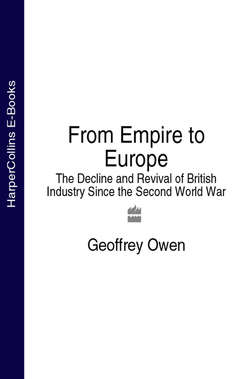Читать книгу From Empire to Europe: The Decline and Revival of British Industry Since the Second World War - Geoffrey Owen - Страница 19
FOUR Textiles: Misdirected Modernisation
ОглавлениеAs the first factory-based industry and one of the principal drivers of the industrial revolution, the textile industry has a special place in British economic history. The extraordinary growth of the cotton textile sector, in particular, was a triumph for the mill owners and merchants of Lancashire. In the 1880s more than 80 per cent of world cotton-cloth exports came from Britain. The subsequent decline of this part of the industry, beginning in the inter-war period and accelerating after 1945, was to a large extent the inevitable result of the spread of industrialisation. The production of cotton textiles, with its relatively simple technology, low capital requirements and easily transportable raw material, was a natural starting-point for developing countries as they began to build up their industries. Many of them moved on from cotton to make a wider range of textiles and clothing, and their low labour costs gave them a competitive advantage in overseas markets. From the 1950s onwards, despite the protective barriers which were raised against them, manufacturers in the developing countries steadily increased their share of world textile production and exports, and the shift is continuing.
Low-cost imports posed particular problems for the British textile industry, especially the cotton textile sector, because of its exceptional size at the start of the post-war period. The response was to restructure the industry through mergers and take-overs. This turned out to be a mistake. Many of the mergers which took place in the 1960s were unwound in the 1980s and 1990s. By contrast, the two most successful European textile industries, those of Italy and Germany, relied mainly on small and medium-sized firms, targeting sectors of the market which were less vulnerable to competition from imports. They also benefited to a far greater extent than the British industry from the expansion of intra-European trade in the 1950s and 1960s. This is a case where the long-standing British bias towards non-European export markets proved to be a serious disadvantage.
